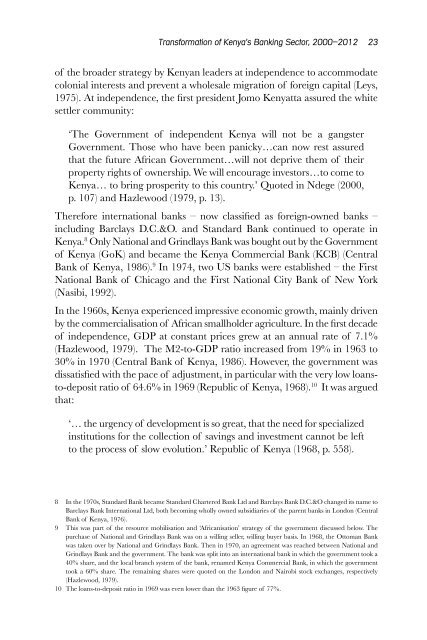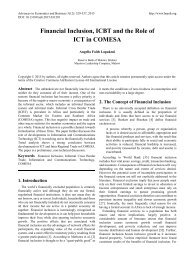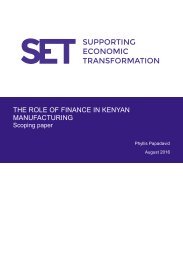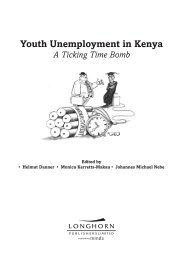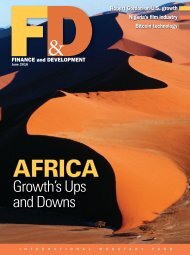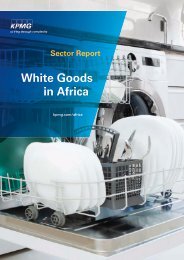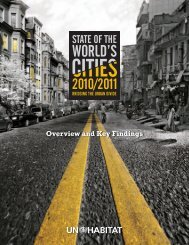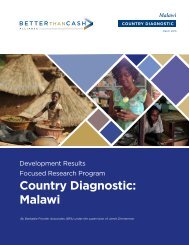in the 21st Century
hTOE305aYVW
hTOE305aYVW
Create successful ePaper yourself
Turn your PDF publications into a flip-book with our unique Google optimized e-Paper software.
Transformation of Kenya’s Bank<strong>in</strong>g Sector, 2000–2012 23<br />
of <strong>the</strong> broader strategy by Kenyan leaders at <strong>in</strong>dependence to accommodate<br />
colonial <strong>in</strong>terests and prevent a wholesale migration of foreign capital (Leys,<br />
1975). At <strong>in</strong>dependence, <strong>the</strong> first president Jomo Kenyatta assured <strong>the</strong> white<br />
settler community:<br />
‘The Government of <strong>in</strong>dependent Kenya will not be a gangster<br />
Government. Those who have been panicky…can now rest assured<br />
that <strong>the</strong> future African Government…will not deprive <strong>the</strong>m of <strong>the</strong>ir<br />
property rights of ownership. We will encourage <strong>in</strong>vestors…to come to<br />
Kenya… to br<strong>in</strong>g prosperity to this country.’ Quoted <strong>in</strong> Ndege (2000,<br />
p. 107) and Hazlewood (1979, p. 13).<br />
Therefore <strong>in</strong>ternational banks – now classified as foreign-owned banks –<br />
<strong>in</strong>clud<strong>in</strong>g Barclays D.C.&O. and Standard Bank cont<strong>in</strong>ued to operate <strong>in</strong><br />
Kenya. 8 Only National and Gr<strong>in</strong>dlays Bank was bought out by <strong>the</strong> Government<br />
of Kenya (GoK) and became <strong>the</strong> Kenya Commercial Bank (KCB) (Central<br />
Bank of Kenya, 1986). 9 In 1974, two US banks were established – <strong>the</strong> First<br />
National Bank of Chicago and <strong>the</strong> First National City Bank of New York<br />
(Nasibi, 1992).<br />
In <strong>the</strong> 1960s, Kenya experienced impressive economic growth, ma<strong>in</strong>ly driven<br />
by <strong>the</strong> commercialisation of African smallholder agriculture. In <strong>the</strong> first decade<br />
of <strong>in</strong>dependence, GDP at constant prices grew at an annual rate of 7.1%<br />
(Hazlewood, 1979). The M2-to-GDP ratio <strong>in</strong>creased from 19% <strong>in</strong> 1963 to<br />
30% <strong>in</strong> 1970 (Central Bank of Kenya, 1986). However, <strong>the</strong> government was<br />
dissatisfied with <strong>the</strong> pace of adjustment, <strong>in</strong> particular with <strong>the</strong> very low loansto-deposit<br />
ratio of 64.6% <strong>in</strong> 1969 (Republic of Kenya, 1968). 10 It was argued<br />
that:<br />
‘… <strong>the</strong> urgency of development is so great, that <strong>the</strong> need for specialized<br />
<strong>in</strong>stitutions for <strong>the</strong> collection of sav<strong>in</strong>gs and <strong>in</strong>vestment cannot be left<br />
to <strong>the</strong> process of slow evolution.’ Republic of Kenya (1968, p. 558).<br />
8 In <strong>the</strong> 1970s, Standard Bank became Standard Chartered Bank Ltd and Barclays Bank D.C.&O changed its name to<br />
Barclays Bank International Ltd, both becom<strong>in</strong>g wholly owned subsidiaries of <strong>the</strong> parent banks <strong>in</strong> London (Central<br />
Bank of Kenya, 1976).<br />
9 This was part of <strong>the</strong> resource mobilisation and ‘Africanisation’ strategy of <strong>the</strong> government discussed below. The<br />
purchase of National and Gr<strong>in</strong>dlays Bank was on a will<strong>in</strong>g seller, will<strong>in</strong>g buyer basis. In 1968, <strong>the</strong> Ottoman Bank<br />
was taken over by National and Gr<strong>in</strong>dlays Bank. Then <strong>in</strong> 1970, an agreement was reached between National and<br />
Gr<strong>in</strong>dlays Bank and <strong>the</strong> government. The bank was split <strong>in</strong>to an <strong>in</strong>ternational bank <strong>in</strong> which <strong>the</strong> government took a<br />
40% share, and <strong>the</strong> local branch system of <strong>the</strong> bank, renamed Kenya Commercial Bank, <strong>in</strong> which <strong>the</strong> government<br />
took a 60% share. The rema<strong>in</strong><strong>in</strong>g shares were quoted on <strong>the</strong> London and Nairobi stock exchanges, respectively<br />
(Hazlewood, 1979).<br />
10 The loans-to-deposit ratio <strong>in</strong> 1969 was even lower than <strong>the</strong> 1963 figure of 77%.


